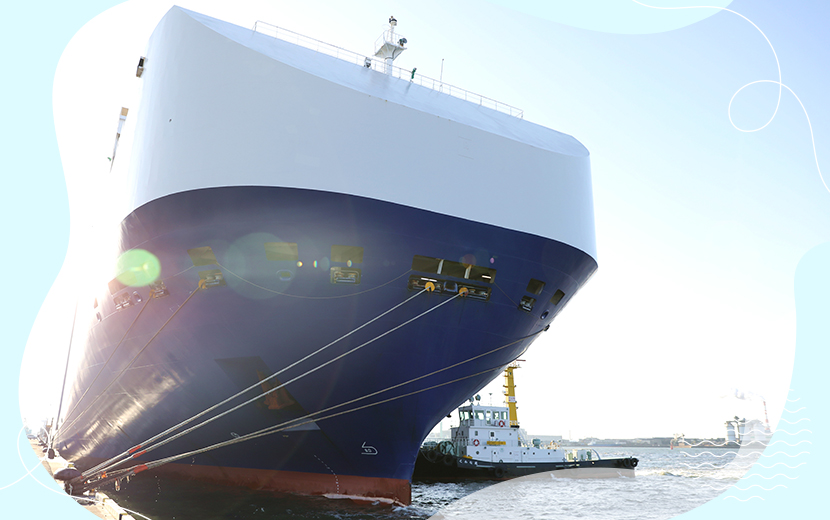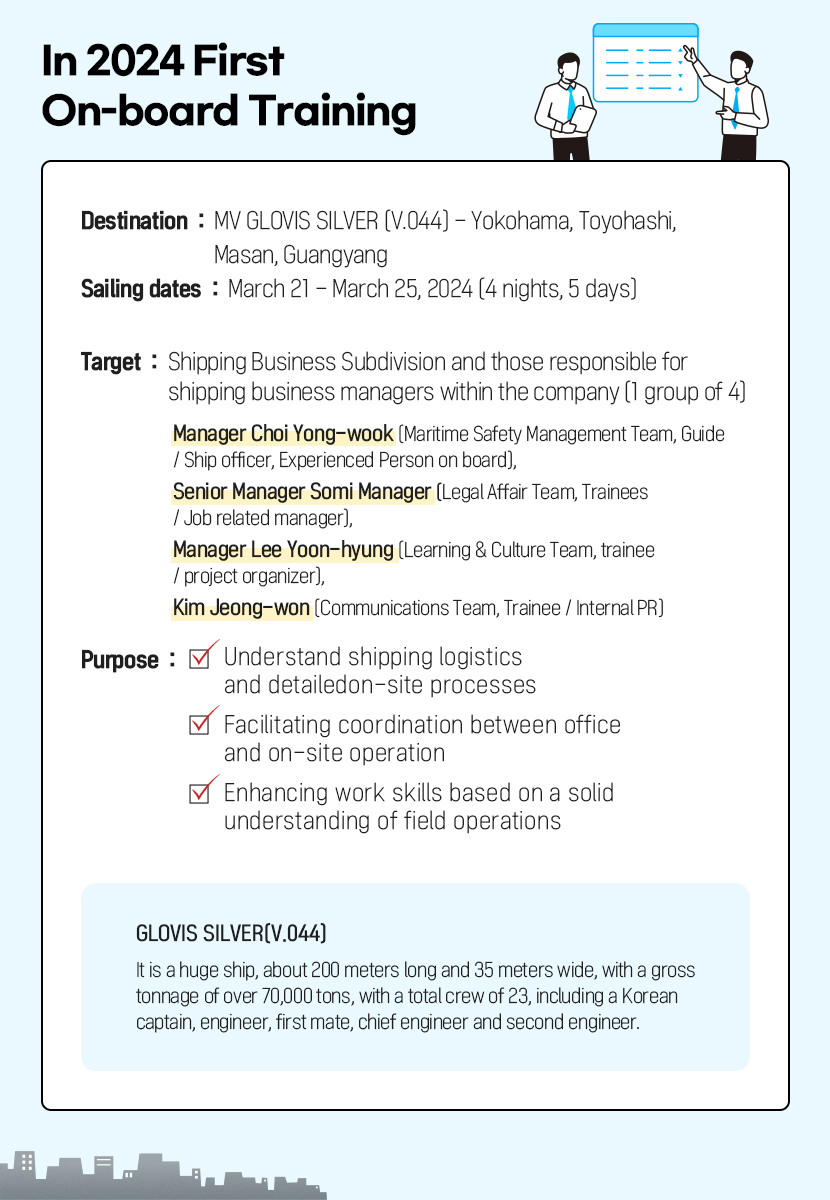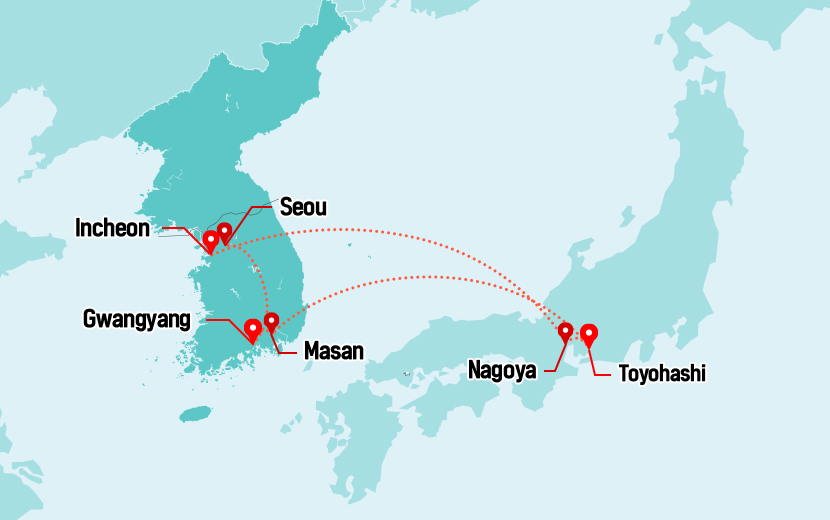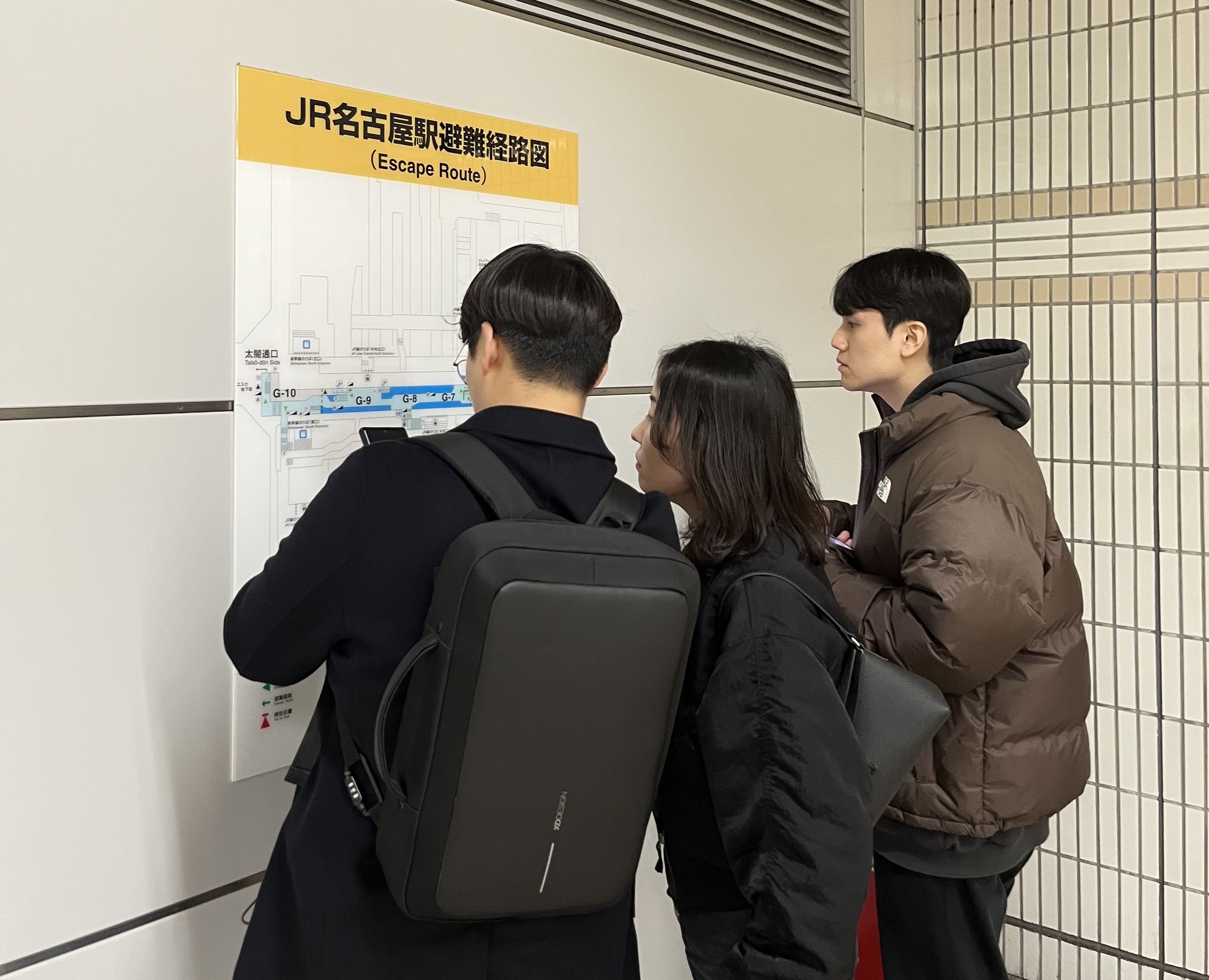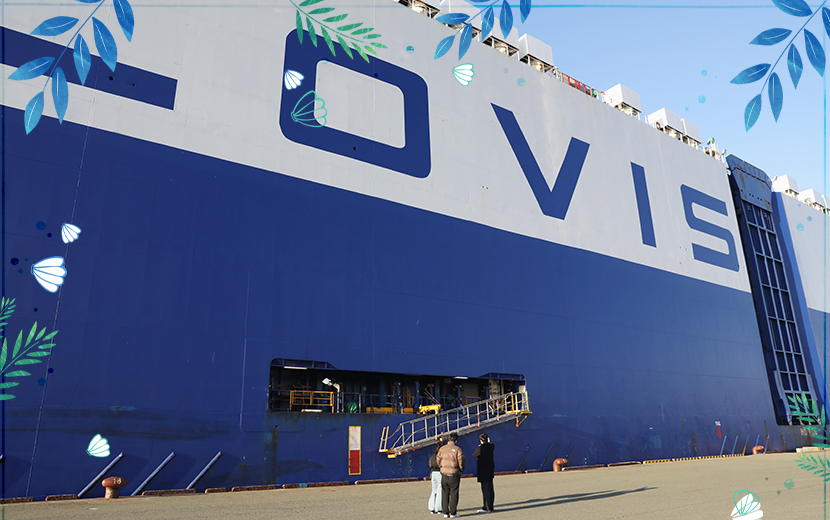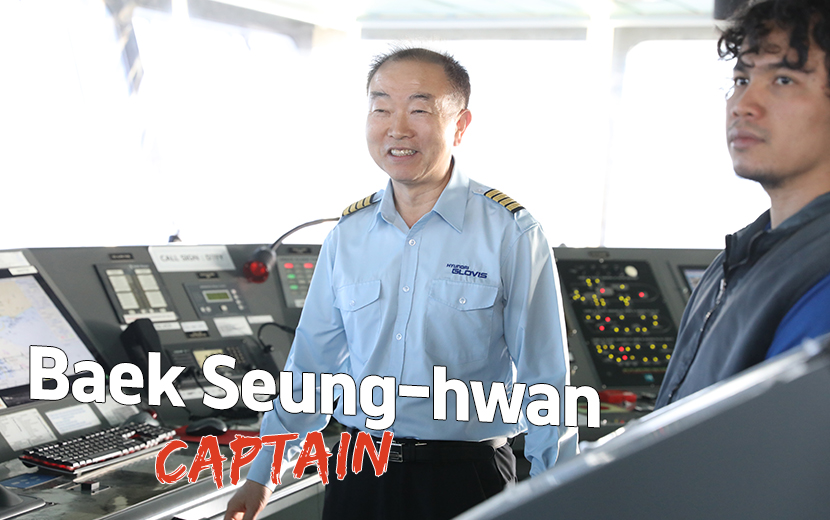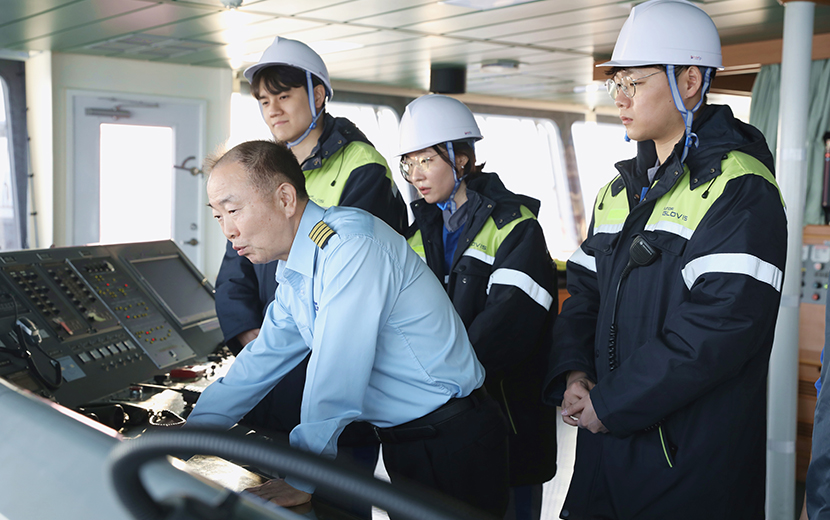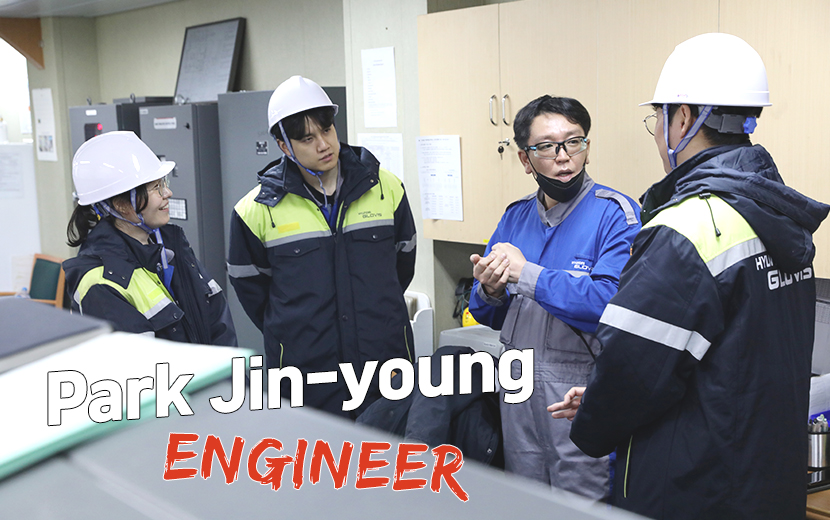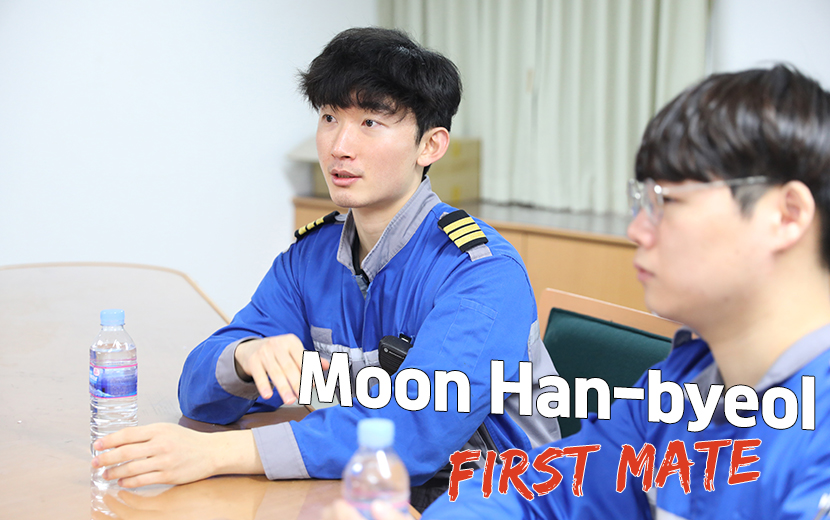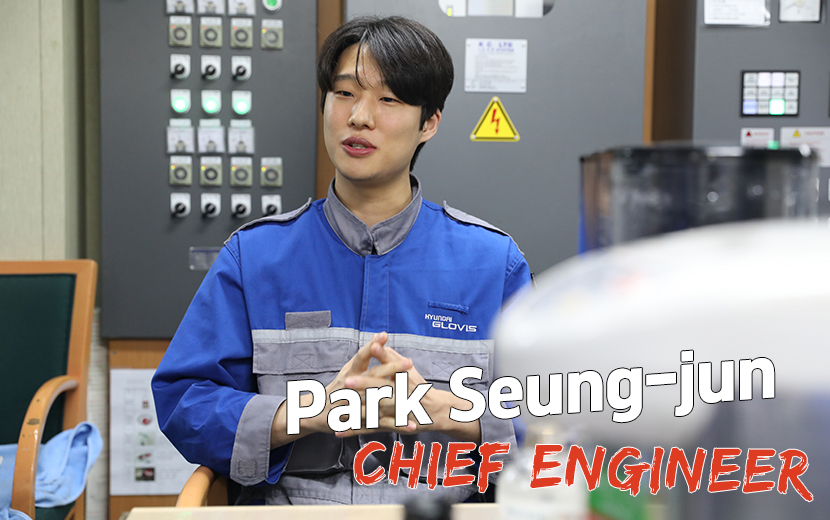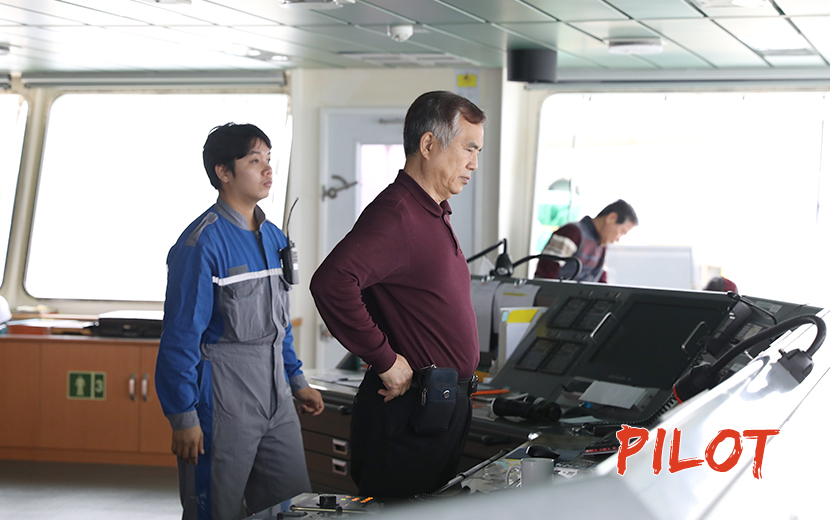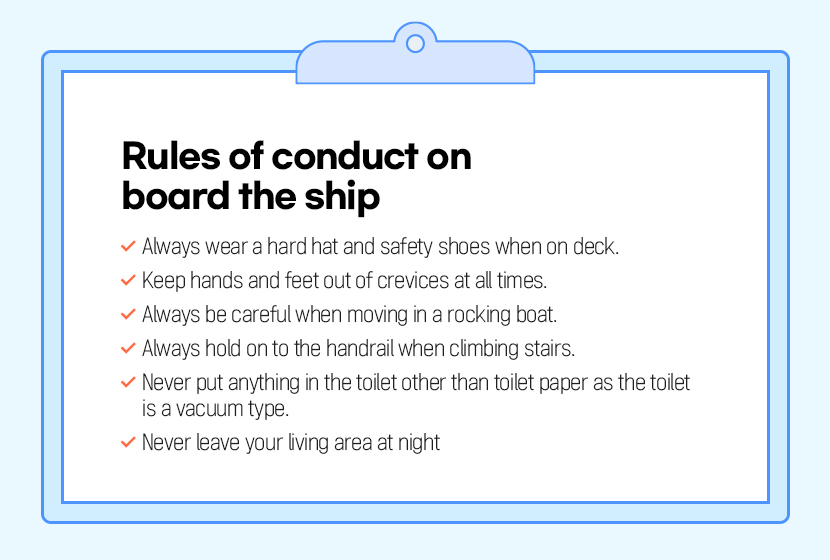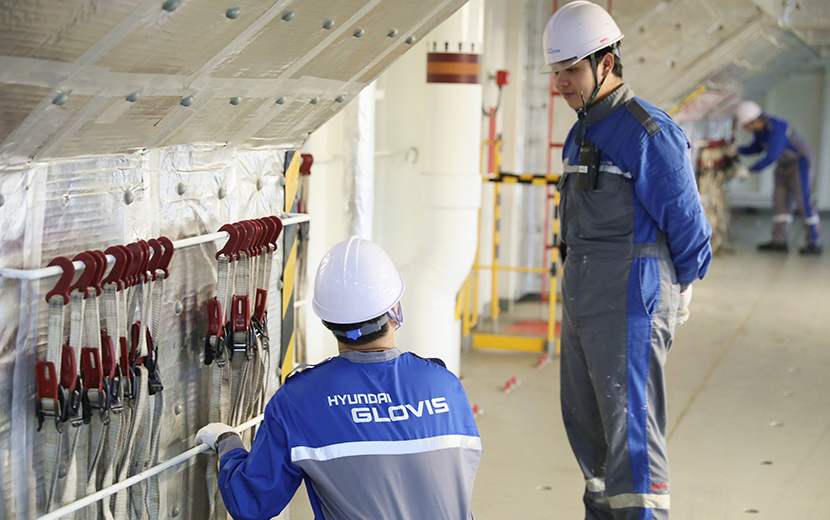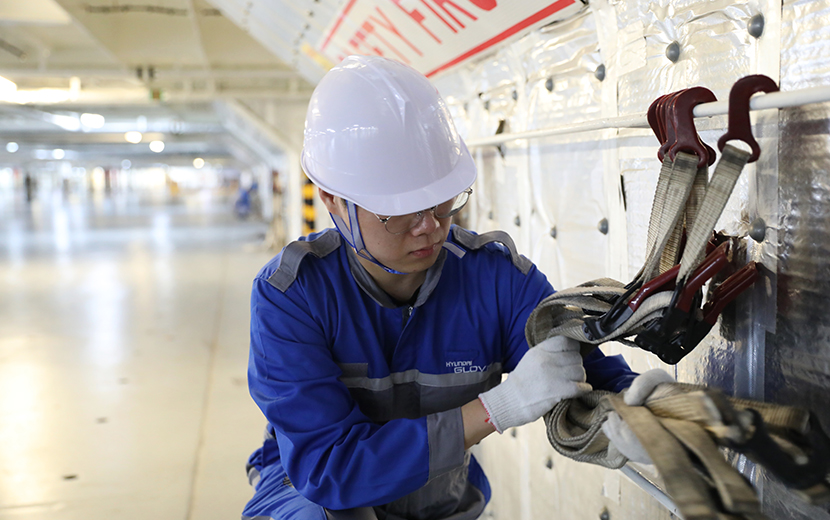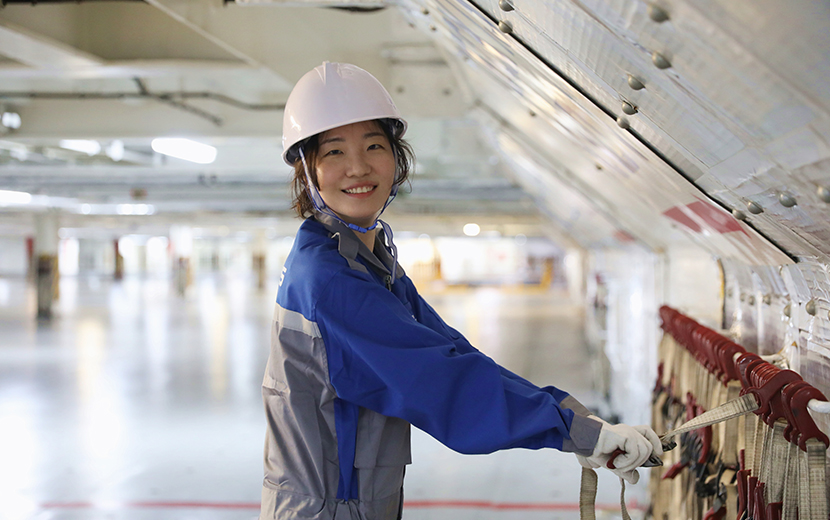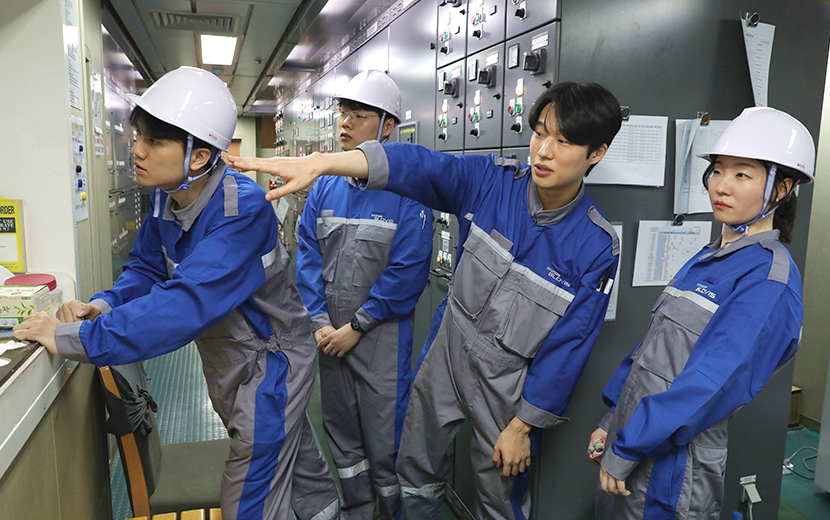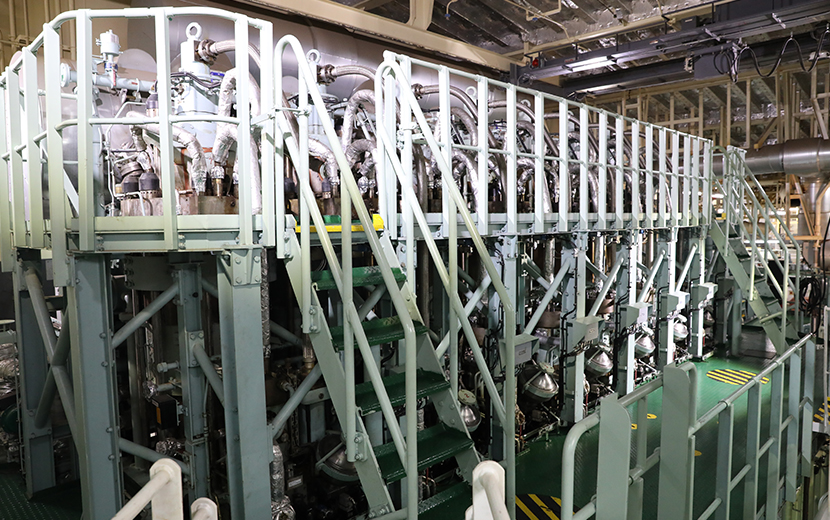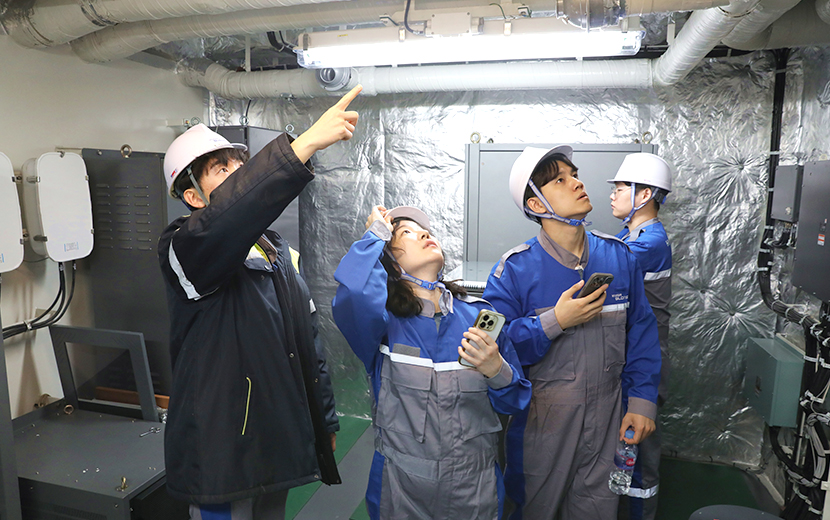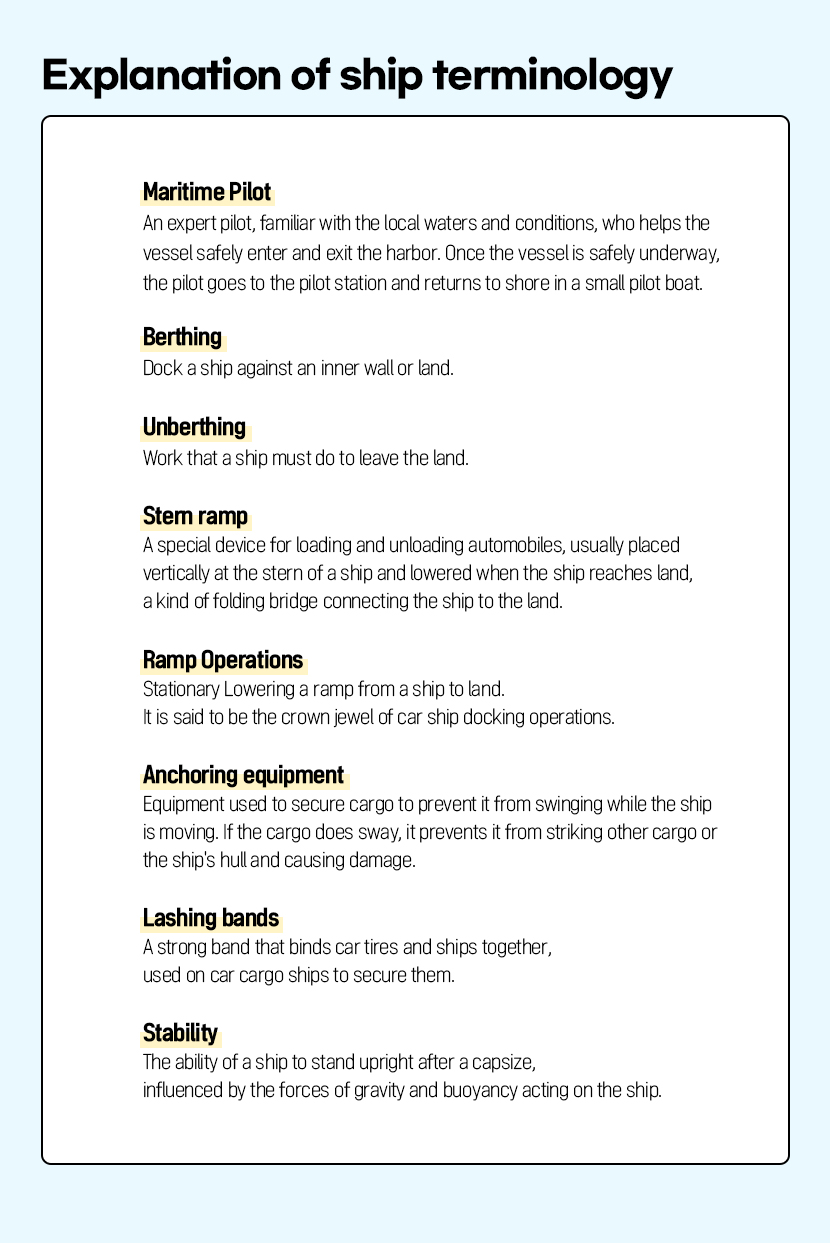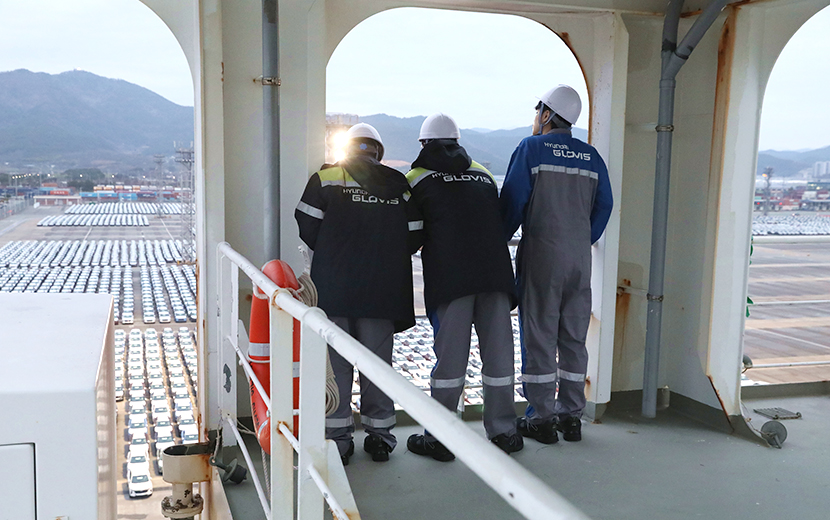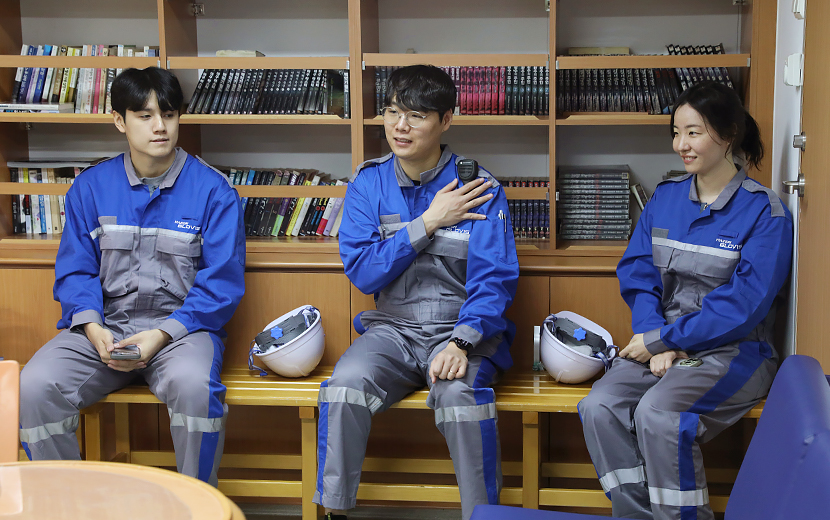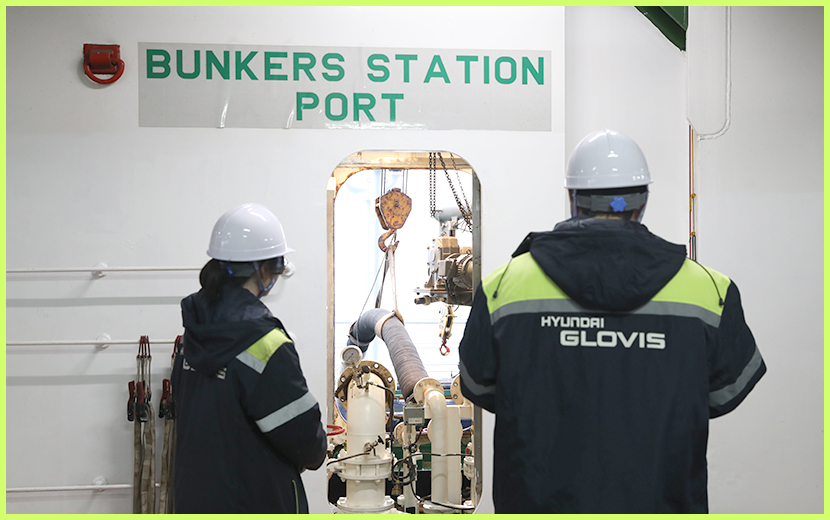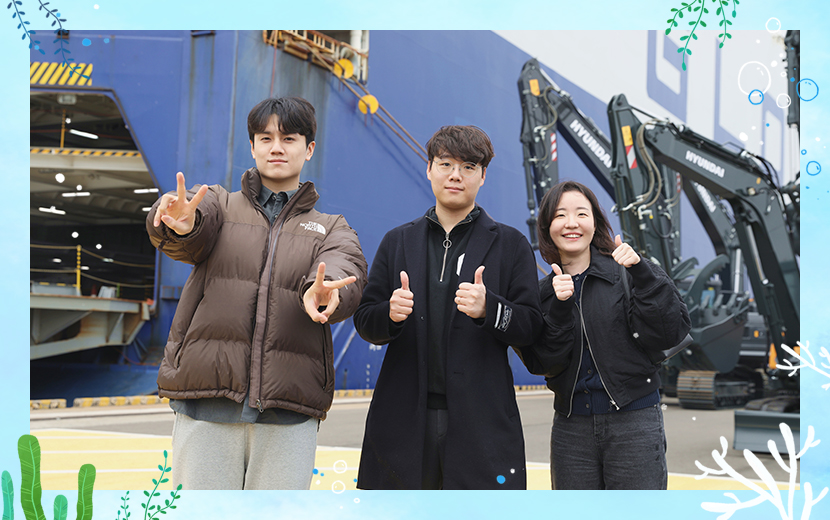Is there anything more powerful than learning by seeing, hearing and experiencing? ‘Onboard Training’ is a program that provides flexible support for onboard and onshore jobs by observing shipping logistics processes aboard Hyundai Glovis’ carriers. Previously run as a pilot program, it was revived this year as a formal vocational training program. The first step was the “24th First Boarding Training” held on a ship sailing to and from Japan. Let’s take a look inside the vivid training program filled with the smell of the sea.
The Hyundai Glovis on-board training was conducted until 2016 and then suspended for various practical reasons. It was revived in 2023, driven by the will of the organization’s leaders, who decided that employees needed on-the-job experience, and the thirst of those in charge to see the actual work on board. The purpose of the program is to provide a positive experience for our employees by strengthening their job knowledge and understanding of the on-the-job practices in the shipping division/related departments. It also aims to increase the sense of belonging and motivation of the participants. As expected and hoped for by all, the trainees’ mastery of shipboard work during last year’s pilot voyage (the third round) brought about noticeable changes on board and ashore. Revived as formal vocational training, on-board training has begun its fourth voyage on a ship bound from Japan to Korea.
Preview of the route of the four trainees on board training
The GLOVIS SILVER, which hosted the first class of trainees in 2024, left Gwangyang Port, South Korea, in January 2024 and was on its way back to Korea after a two-month voyage to the Americas and a stopover in Japan. The first group of trainees, Senior Manager Somi (Legal Affair Team), Manager Kim Jeong-won (Communication Team), Manager Lee Yoon-hyung (Learning & Culture Team), and their guide, Manager Choi Yong-wook (Maritime Safety Management Team), departed Incheon Airport on the morning of March 21 and arrived at Nagoya Chubu International Airport around noon. This was the first time they had actually met and talked to each other, although they had been in contact via e-mail and the company’s SNS. But was it the inner closeness of being on the same boat for the next five days? The four members of the first crew training class, who had gathered like knives without anyone being late, chatted easily during the wait at the airport and on the flight.
The team was scheduled to travel by train from Chubu Centrair International Airport to Toyohashi Port, but an unexpected natural disaster sent them on an unexpected journey. To get to Toyohashi Port, they had to go through Nagoya Station, and the train service from the airport to Nagoya Station was canceled due to strong winds. The team was stuck in an unfamiliar city with no communication and crowds and had to transfer between trains. Fortunately, the group remained calm as they scattered and got lost, and everyone made it to Nagoya Station without incident. Finally relaxed, the team enjoyed a late lunch and dinner before the program began in earnest with final checks and physical conditioning for the next day’s embarkation.
To get to the train station, trainees look at a subway map!
It’s finally time to go on board. The GLOVIS SILVER was scheduled to arrive early in the morning, so the training team gathered in the hotel lobby at 6:15. The training team was met by Mr. Mori-san, a local agent who handles all the formalities for Hyundai Glovis ships in Japan, and traveled to Toyohashi Port. When they arrived at Toyohashi Port, the ship had already arrived at the dock and was docking. It was early morning with a strong sea breeze, but the team was overwhelmed by the size of the ship and watched the berthing process intently. After the connection of all ropes for the attachment of the ship to the land, the stern lamp operation began.
lowering the stern lamp
Stern lamp from the inside
After watching the ship berth for about an hour, we went to the Japanese immigration office to check out of Japan. Although the team was traveling as passengers, the immigration process itself was conducted as crew members. After completing the customs inspection at the Toyohashi office of Japan Customs, the team was finally allowed to leave the country and boarded the ship.
Trainees in Toyohashi port
Chief Mate took the training
Chief Engineer took the training
The GLOVIS SILVER was unloaded its cargo from the United States at the Toyohashi Pier. The training team was greeted by the Third Mate Nicholas on duty at the gangway, a passageway for outsiders to enter and exit the ship, and then escorted by the Trainee Mate Andrew to the ship’s living quarters, where they were assigned rooms for the next three days and four nights. The single room with private bathroom was fully equipped with all the necessities, including tissues and towels, as well as work clothes and safety shoes. After unpacking and a lunch of spicy soup prepared by the Filipino chef, the team was greeted by the offshore staff and given a briefing on the ship’s rules and regulations before being taken on a tour of the ship by Chief Mate Moon Han-byeol, who explained each area of the ship and gave them emergency safety training.
At 15:00, it was time to set sail from Toyohashi. The training team traveled to the bow (the front part of the ship) to watch unberthing work on the rope that connects the ship to the land, which is then pulled back from the shore. The rope, which is as thick as an average adult’s thigh, is coiled up with tremendous force and is done in a safe area under the direction of the first mate, as the damage could be catastrophic in the event of an accident. Once the ship was away from shore, the team watched the maritime pilot disembark at the pilot station, and then returned to the mission to hear a briefing from Captain Baek Seung-hwan on the voyage’s itinerary, concluding the first day’s official schedule.
The bridge at night
The first morning at sea. The training team gathered in the corridor at 4:45 a.m. to experience the early morning watch of a navigator. A navigaiton watch is typically divided into three four-hour shifts (0-4am/4-8am/8-12am/12-16am/16-20am/20-24am). Navigators on the 4-8am watch are expected to be on the bridge by 3:45am. Unlike the day watch, the most important thing to remember about the night (dawn) watch is that no light is allowed to shine through at night, except for the dim light of the navigation equipment required for the mission. On a pitch-black night, you’ll need to see the lights of other ships to avoid collisions, as you won’t be able to see them when your mission lights are on. Even small lights, such as cell phone lights or camera flashes, can distract navigators. The original watch is four hours, but with multiple training sessions scheduled, the team only got to experience the watch from 5am to 7am.
Organization of the Cargo Lashing Gear
A boat for emergency escape
The main task of the day is to organize the lashing bands in the ship’s hold. After a safety briefing by the chief mate, a short gymnastics routine was performed to warm up before the hard work began. The number of lashing bands to be organized that day was about 3,000. Training team collected the lashing bands from the floor of the hold, hung them on a wall rack, and balanced the lanyards to make sure they were evenly spaced from side to side, just like adjusting the length of a bag strap. The organizational work was done quickly, and after checking the ship’s life-saving equipment (lifeboats, life jackets, etc.) and various warehouse that we hadn’t checked yesterday, we returned to the living quarters.
Observing Captain Baek Seung-hwan communicate with shore was one of the highlights of the day. At least once a day during the voyage, the ship sends a report to the shore to inform them of the ship’s status, usually at noon on a typical voyage, which is called Noon Reporting. This report is called the Noon Report. It records the ship’s position, weather conditions, distance traveled since the last report, and the amount of fuel used, and is an important resource for shore-based personnel to check the ship’s status. I also saw how the mission organizes and manages records and documents. Unlike on land, where digital paperwork such as e-payments and Teams have been adopted, most of the paperwork is still done by hand. The most important of these is the ship’s Deck Log book. It’s filled out every hour, even when nothing is happening, and when certain events occur, they are recorded by the navigator on duty. The deck log book should never be left unattended and should be kept by the officer on duty, and carried in case of emergency.
The team observed the second mate planning a route for a domestic coastal passage and the captain and first mate discussing the ship’s endurance. When planning a route, many factors are considered, such as whether the water is deep enough, whether the route is too close to land, and whether it complies with the country’s laws and regulations. A ship’s stability is determined by many factors, including the weight and location of the cargo currently on board, the amount of fuel oil and ballast water, and weather conditions, and varies from port to port. Maintaining resilience at a safe level at all times is a critical task for the captain and first officer. The day ended with the team experiencing the heart of the ship, the engine room. The main engines were running at full throttle, so the group donned earplugs and headed to the engine room to listen to the chief mate explain each machine.
Tugboat for berthing
Deck crew working on berthing operations
Entering Masan Port
Three trainees helping to carry the side dish
After a night at sea, as the ship slowly approaches the dock at Masan Harbor, Captain Baek Seung-hwan gives the order for all crew members to prepare to board and disembark the ship. All crew members participate in the loading and unloading operations. The training team moved to the stern (the back of the ship) to observe the second mate and the docking operations. When entering a port, the ship’s ropes must be attached to a fixture on shore and wound tightly to secure the ship. This process requires extreme caution, as a broken rope or snagged propeller can lead to a major accident. The training team landed just two days after completing the quarantine and immigration formalities required of ships returning from a voyage. They helped the crew load months’ worth of food onto the ship for the next voyage, took care of their own business on shore (verification required), and then boarded again. The thought of it being my last night on board made them sentimental, but I reminded myself of the safety rules, because a small lapse in vigilance can lead to a big accident.
Arrival at Gwangyang Port
The five days of training aboard Baek Seung-hwan concluded with the captain and pilot observing the ship’s docking at Gwangyang Port. The last part of the training was to observe the bunkering operation, where fuel oil is supplied to the ship. Each fuel oil tank must be filled with exactly the right amount of fuel oil. The way to measure the fuel oil in a tank is to insert a tape measure into a tube located above the tank and measure the length of oil that comes out on the tape measure to calculate the amount of oil in the tank. The training team disembarked from the GLOVIS SILVER before the bunkering was completed. Guided by the Gwangyang agency staff, they stopped at the Gwangyang Ministry of Justice Immigration Office and Gwangyang Customs Office to complete the disembarkation procedures. Trainees; guide – Manager Choi Yong-wook, and Senior Manager Somi, Manager Lee Yoon-hyung and Manager Kim Jeong-won were transferred from the ship to land.
Bunker Station

![]() How did you feel after completing the 4-day, 5-night ’24 Year First Officer Training’?
How did you feel after completing the 4-day, 5-night ’24 Year First Officer Training’?
I feel very fortunate that we were able to get through the boarding training without any incidents at all. Although there were sections where the ship rolled heavily due to bad weather, the active and friendly cooperation of the ship’s maritime staff allowed the trainees to safely experience the work of various departments. We hope that this training will serve as an opportunity to enhance mutual understanding between land and sea, and ultimately contribute to the development of Hyundai Glovis.
![]() Did you organize your own onboarding training program? What did you focus on?
Did you organize your own onboarding training program? What did you focus on?
This is my first time leading a training program. I studied nautical science at university and worked as a sailor for about four years, so when I heard that the training program was being revived, I wanted to lead it. The motto of the training program is “experience shallow and wide”. Originally planned for the Toyohashi-Masan section, the program was extended to Gwangyang as it was felt that the training would be insufficient. The program was structured according to each participant’s desired training content and the ship’s schedule. It was based on pre-planning, but flexible on the spot, as unexpected situations can arise in the field.
![]() Were there any special considerations for the trainees who weren’t used to working on a ship?
Were there any special considerations for the trainees who weren’t used to working on a ship?
We always put safety first. On a ship, there are many dangerous tasks that can lead to a serious accident if you let your guard down for even a moment. Every time we moved to a new location or trained for a new task, we gave them contextualized precautions and set up a safe zone so they could only move within it. We also took precautions each night before going to bed, including the next day’s meeting time and safe clothing.
![]() What should we add to our next onboarding training based on this experience?
What should we add to our next onboarding training based on this experience?
After boarding, the ship’s personnel may be busy with docking and other duties, making it difficult to provide immediate training. In addition, due to the nature of coastal shipping (a fleet that sails close to land, regardless of the nationality of the port), shipboard personnel are often fatigued by frequent arrivals and departures and cannot focus solely on training. As a complementary measure, it would be good to strengthen pre-boarding training before departure.

(From left) Manager Lee Yoon-hyung, Manager Choi Yong-wook, Senior Manager Somi
![]() What was the most impressive thing you learned during your onboarding training?
What was the most impressive thing you learned during your onboarding training?
The whole process of the ship coming into port, berthing, departing, and moving. When “All Crew Standby” is announced at the time of arrival and departure, all offshore employees wake up from their sleep to perform the work. Especially the work using ropes is urgent and dangerous, so it was nerve-wracking just to watch. All the experiences I saw and learned were valuable. I will repay you with high-quality legal services.
It was a special time to experience firsthand the life of offshore workers. I was able to see and learn what goes on aboard the ship, not only in the work area, but also in the living area. Everyone was very kind to me and I left with nothing but good memories.
![]() How do you think this onboarding will help you in your practice?
How do you think this onboarding will help you in your practice?
I am currently responsible for maritime legal affairs. By seeing and experiencing ships and operations directly related to my work, such as supporting various claims and reviewing contracts, I was able to gain a three-dimensional and comprehensive understanding of situations that I had only encountered on paper. It was time to strengthen my professional skills to support the shipping department.
I believe that understanding our business is essential in order to perform training tasks and HR tasks in general. I was able to gain a better understanding of on-board training by experiencing the main tasks, processes and procedures in the ports and on board the ships. As a member of the Education and Culture team, I will support the Shipping Business Strategy team to ensure that on-board training is established as a company-wide process.

![]() How did you come up with the idea for onboarding training?
How did you come up with the idea for onboarding training?
Onboard training is a dream come true for every employee in the shipping industry. In our case, until the outbreak of COVID-19, it was a business unit’s own training, often conducted in the cabin for juniors. When the pandemic was declared, there was active support from the top of the organization, including the head of shipping, to resume the training. Based on past materials and experiences, we wanted to make it a formal program and create a real on-board training opportunity.
![]() What is the purpose and what is the importance of onboarding?
What is the purpose and what is the importance of onboarding?
Two things were important to the Shipping Business Subdivision from the very beginning. One was to shorten the distance between the desk and the field, and the other was to go beyond training in terms of jobs to motivation in terms of feeling proud to be part of the company.
![]() What was your main focus in designing this onboarding training program?
What was your main focus in designing this onboarding training program?
This is the first formal training organized by the Education and Culture team and the Shipping Business Strategy team. Safety is always paramount. To ensure safety, we selected experienced seafarers from shipping companies as instructors and assigned them to be in charge of the training site.
![]() After your onboarding training, are you seeing results?
After your onboarding training, are you seeing results?
As a planner, I haven’t had the opportunity to attend the onboard training yet, but I have received feedback that it is very well received and very helpful in practice. Personally, I would love to experience it, but for safety and local guidance, we have a maximum of four people per trip, so even if there are eight trips a year, there are only twenty-four spots for TOs. I think it’s right to prioritize those who really need it.
![]() What were the successes and disappointments of this boarding training?
What were the successes and disappointments of this boarding training?
Overseas business trips are usually planned, prepared and packed months in advance. However, shipboard training is usually confirmed three weeks in advance if it is relaxed, and one or two weeks in advance if it is urgent, depending on the ship’s schedule. In this case, the schedule was so tight that the flight was not confirmed until two days before departure. I imagine that the pressure and stress on the instructors and trainees must have been high, especially after hearing about the sudden cold snap on the day of embarkation at Toyohashi Port in Japan, I wondered if there was a lack of preparation at the headquarters. Despite the tight schedule, I am proud that we were able to complete the training safely and with unwavering enthusiasm until the additional embarkation leg.
![]() What would your advice be to future participants who will be on board with us in the future?
What would your advice be to future participants who will be on board with us in the future?
I believe that seeing and feeling as much as you know is the foundation of personal development. Starting this year, we are extending our onboard training to all employees. I will do my best to bridge the gap between the desk and the field and provide opportunities for professional and personal growth. Von Voyage!
By Editorial Department
2024.04.19


